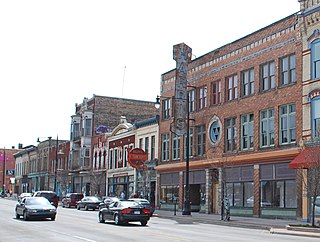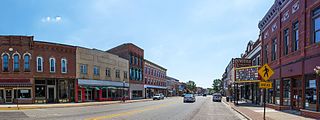
Lansing is the capital of the U.S. state of Michigan. It is mostly in Ingham County, although portions of the city extend west into Eaton County and north into Clinton County. The 2020 census placed the city's population at 112,644, making it the sixth largest city in Michigan. The population of its metropolitan statistical area (MSA) was 541,297 at the 2020 census, the third largest in the state after metropolitan Detroit and Grand Rapids. It was named the new state capital of Michigan in 1847, ten years after Michigan became a state.

The Capitol Loop is a state trunkline highway running through Lansing, Michigan, in the United States that was commissioned on October 13, 1989. It forms a loop route off Interstate 496 (I-496) through downtown near the Michigan State Capitol complex, home of the state legislature and several state departments. The Michigan Department of Transportation (MDOT) has labeled it as Capitol Loop I-496 or CL I-496 on some maps, similar to the Business Loop Interstate nomenclature. However, unlike other business loops in Michigan, it has unique reassurance markers—the signs that serve as regular reminders of the name and number of the highway. It is known internally at MDOT as Connector 496 for inventory purposes. The route follows a series of one-way and two-way streets through downtown Lansing, directing traffic downtown to the State Capitol and other government buildings. Unlike the other streets downtown, the seven streets comprising the Capitol Loop are under state maintenance and jurisdiction.

The Capitol Park Historic District is a historic district located in downtown Detroit, Michigan. It is roughly bounded by Grand River, Woodward and Michigan Avenues, and Washington Boulevard. The district was listed on the National Register of Historic Places in 1999.

The Randolph Street Commercial Buildings Historic District is a historic district located in Downtown Detroit, Michigan, which includes six buildings along Randolph Street between Monroe and Macomb streets. The district was listed on the National Register of Historic Places in 1980. The collection of buildings are a rare surviving set of Detroit Victorian-era commercial structures. The Randolph Street Commercial Building Historic District joins the Broadway Avenue Historic District downtown.

The Clinton Downtown Historic District is a historic district located in the village of Clinton in Clinton Township in the northernmost portion of Lenawee County, Michigan. It consists of most of the 100 block of U.S. Route 12, known locally as West Michigan Avenue, plus Memorial Park at 200 West Michigan. The district was added to the National Register of Historic Places on April 27, 2010.

The Hudson Downtown Historic District is a historic district comprising the downtown area of the city of Hudson in westernmost Lenawee County, Michigan. It was designated as a Michigan Historic Site on January 21, 1974. It was later added to the National Register of Historic Places on December 24, 1974.

The Central Methodist Episcopal Church is a historic church located at 215 North Capitol Avenue in Lansing, Michigan. It was listed on the National Register of Historic Places in 1980.

Downtown Lansing is the central business district of Lansing, Michigan, United States. Located in the west-central part of the city along the banks of the Grand River, downtown Lansing is primarily home to Michigan's state government and three colleges, and also contains sports facilities, museums, entertainment and retail, and a growing residential population.

The Chelsea Commercial Historic District is a historic district located along both sides of Main Street from Orchard to North Street in Chelsea, Michigan; the district also includes the adjacent 100 blocks of Jackson, East Middle, and West Middle Streets, as well as structures on Park, East, and Orchard Streets. It was listed on the National Register of Historic Places in 2011.

Heartside is a neighborhood located near downtown Grand Rapids, Michigan. Heartside district is a developing area in the city known for its art. It has restaurants, a park with a playground and splash-pad, and a recently opened farmer's market. However, it also has experienced much urban decay, features numerous abandoned buildings, and contains a large presence of homelessness.

Argos Downtown Historic District is a national historic district located at Argos, Marshall County, Indiana. The district encompasses 21 contributing buildings in the central business district of Argos. It developed between about 1867 and 1942, and includes examples of Italianate, Romanesque Revival, and Neoclassical style architecture. Notable buildings include the Reed Block (1891), Williams Inn (1838), IOOF #263 Hall (1901-1907), Corner Hardware Building (1883), Argos Reflector Building / GAR Hall, Argos Theater, Sarber Building (1892-1898), Old Argos Opera House / Huff Block (1887-1892), Pickerl Block, Argos Municipal Building (1940), Farmers State Bank Block (1917), Argos Masonic Lodge #399 / Grossman Building (1906), Schoonover Building, and Pickerl Residence.

The Grand Haven Historic District is a mixed commercial and residential historic district located along Washington Avenue and adjacent Streets from Harbor Drive through the 600 block, in Grand Haven, Michigan. The district was listed on the National Register of Historic Places in 2016.

The Buchanan Downtown Historic District is a primarily commercial historic district located in Buchanan, Michigan between 117 W. and 256 E. Front Street and between 108 and 210-212 Main Street, along with adjacent sections of Oak Street and Days Avenue. The district was listed on the National Register of Historic Places in 2009.

The Downtown Three Rivers Commercial Historic District is a commercial historic district located along North Main Street, between Michigan and Portage Avenues, in Three Rivers, Michigan. It was listed on the National Register of Historic Places in 1982.

The Blissfield Downtown Historic District is a historic district located in the village of Blissfield, Michigan, and roughly bounded by Pearl Street on the west, Giles Avenue on the east, Jefferson Street on the south, and Adrian Street and the Blissfield railroad line on the north. The district was added to the National Register of Historic Places in 2015.

The Bay City Downtown Historic District is a primarily commercial historic district, located in Bay City, Michigan and roughly bounded by the Saginaw River, Second Street, Adam Street, and Center Avenue. It was listed on the National Register of Historic Places in 1985.

The 'Ionia Downtown Commercial Historic District is a primarily commercial district located roughly along West Main and Washington Streets, from Dexter Street to Library Street, in Ionia, Michigan. The district was listed on the National Register of Historic Places in 1984.

The Portland Downtown Historic District is a primarily commercial historic district located along Kent and Maple Streets, between Academy Street and the Looking Glass River, in Portland, Michigan. It was listed on the National Register of Historic Places in 2005.

For other Haymarket districts see Haymarket District (disambiguation)

The Vicksburg Historic District is mixed commercial and residential historic district located primarily along Main Street, Michigan Avenue, and Kalamazoo Avenue, and adjacent portions of Prairie, Washington, Maple, South, and Park Streets in Vicksburg, Michigan. It was listed on the National Register of Historic Places in 2022.






















